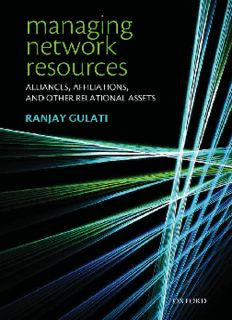
Managing Network Resources: Alliances, Affiliations, and Other Relational Assets PDF
Preview Managing Network Resources: Alliances, Affiliations, and Other Relational Assets
Managing Network Resources Alliances, Affiliations and Other Relational Assets This page intentionally left blank Managing Network Resources Alliances, Affiliations and Other Relational Assets Ranjay Gulati 1 3 GreatClarendonStreet,Oxfordox26dp OxfordUniversityPressisadepartmentoftheUniversityofOxford. ItfurtherstheUniversity’sobjectiveofexcellenceinresearch,scholarship, andeducationbypublishingworldwidein Oxford NewYork Auckland CapeTown DaresSalaam HongKong Karachi KualaLumpur Madrid Melbourne MexicoCity Nairobi NewDelhi Shanghai Taipei Toronto Withofficesin Argentina Austria Brazil Chile CzechRepublic France Greece Guatemala Hungary Italy Japan Poland Portugal Singapore SouthKorea Switzerland Thailand Turkey Ukraine Vietnam OxfordisaregisteredtrademarkofOxfordUniversityPress intheUKandincertainothercountries PublishedintheUnitedStates byOxfordUniversityPressInc.,NewYork ©RanjayGulati2007 Themoralrightsoftheauthorhavebeenasserted DatabaserightOxfordUniversityPress(maker) Firstpublished2007 Allrightsreserved.Nopartofthispublicationmaybereproduced, storedinaretrievalsystem,ortransmitted,inanyformorbyanymeans, withoutthepriorpermissioninwritingofOxfordUniversityPress, orasexpresslypermittedbylaw,orundertermsagreedwiththeappropriate reprographicsrightsorganization.Enquiriesconcerningreproduction outsidethescopeoftheaboveshouldbesenttotheRightsDepartment, OxfordUniversityPress,attheaddressabove Youmustnotcirculatethisbookinanyotherbindingorcover andyoumustimposethesameconditiononanyacquirer BritishLibraryCataloguinginPublicationData Dataavailable LibraryofCongressCataloginginPublicationData Dataavailable TypesetbySPIPublisherServices,Pondicherry,India PrintedinGreatBritain onacid-freepaperby BiddlesLtd.,King’sLynn,Norfolk ISBN 978-0-19-929935-5 ISBN 978-0-19-929985-0(Pbk.) 1 3 5 7 9 10 8 6 4 2 Tomyparentswhogavemethethirsttolearn To my teachers, colleagues, and students from whom I have learnedsomuch Tomyfamilywhohavesupportedmeonthisjourneytolearn This page intentionally left blank (cid:0) PREFACE Myresearchoverthelastdecadehasshownthatinterorganizationalnetworks not only influence the creation of new ties between organizations but also affect their design, evolutionary path, and success. I subsequently extended some of these ideas to other types of interorganizational ties in contexts rangingfromlargetoentrepreneurialfirms.Thisbookbringstogethermuch of this research under one fold. Most of the chapters draw heavily from my publishedarticles,manyofwhicharecoauthored.Atthestartofeachchapter, Iclearlyindicatethepublishedsourcefromwhichthechapterhasbeendrawn and also acknowledge my, coauthors, if any for that published work. While I have adapted the front end of these chapters to draw out the common threadofnetworkresourcesthatcutsacrossthebook,theresearchreportedis fromtheoriginalarticlesmentionedattheoutsetofthechapter.Somedetails onthedataandmethodshavebeenabbreviatedforthebook.Whilesomeof the chapters in this book are based on solo-authored articles, in the case of coauthoredchaptersitisimportanttonotethattheresearchreportedisbased oncollaborativeworkwiththelistedauthors. This book is more than simply a retrospective collection of my published work.Allthechaptershavebeenadaptedtocohereunderacommonunifying theme. In doing so, I have recrafted the conceptual underpinnings of the articles to allow them to be parts of a broader story. In some sense this was anexerciseformetotrytodrawoutacommonthreadthatranacrossmany ofmypriorworksandtodosomeretrospectivesense-making. Indrawingonthesociologicalparadigmofembeddednesstoexplaininter- firmbehavior,Idevelopheretheconceptof‘networkresources’asanimpor- tant but overlooked factor to explain both firm behavior and outcomes in interorganizational collaboration. Network resources are valuable resources thataccruetoafirmfromitstieswithkeyexternalconstituentsincluding— butnotlimitedto—partners,suppliers,andcustomers,andthusexistoutside a firm’s boundaries and within its social networks. Networks thus become conduits that make available to firms valuable resources and information that may reside within their partners. The ties are thus sources of valuable resources and information that can influence strategic behavior by altering theopportunitysetofactionsavailabletoafirmandalsooutcomesbymaking availableresources.Theymayalsobeviewedbyexternalconstituentsassignals oflegitimacyinasmuchastheysignaltheavailabilityofkeyresourcestothose firms. Consequently, the manner and extent to which a firm is embedded in a prior interorganizational network enable firms to obtain resources and viii PREFACE information that significantly influence the behavior and also key outcomes fortheparticipatingfirms. Whileseveralchaptersinthefirsttwopartsofthisbookfocusondemon- strating the impact of network resources originating in a firm’s network of prioralliances,Ialsoreflectinseveralsubsequentchaptersonotherpossible networks from which such resources may be derived and how these influ- ence firm behavior and outcomes. Further, I consider the likely dynamic of co-evolution of disparate networks in which the accumulation of one may facilitatetheacquisitionoftheother,openingupmultipleconduitsforfirms. This suggests a complex interplay across disparate networks that shape each other and through this coevolutionary process impact the cumulative net- work resources that become available for participating firms. For example, in some chapters I examine how accumulated prior alliances of firms shape the creation of new such ties. In others I consider the role of interpersonal tiessuchasboardinterlocksininfluencingallianceformation.Finally,Ialso studytheinfluenceofprioremploymentandboardtiesofupperechelonsof entrepreneurial firms on the likelihood of landing partnerships with higher prestige investment banks. The settings in which these ideas are explored rangefromlargeUSandglobalcorporationstostart-upsinthebiotechnology sector. Inlookingbackatsomeofmyownpublishedworkthatisincludedhere,I discoveredthatIhadnotalwaysreferredtothecoreconstructinthosearticles asnetworkresources.ThetermsIusedbeforerangefrom‘embeddedness’to ‘relationalcapital’.Inbringingthesedisparateworkstogether,Ihavetriedto streamlinethetermsandbringeverythingunderthesinglerubricofnetwork resources. I hope that by doing so, I bring greater clarity to the reader and sharpenthemessagewhilealsoprovidingaconsistentthreadthatrunsacross thiswork.Asthesearticleswerenotwrittenwiththisunifyingthemeinmind, theycontainelementsthatwereimportantintheoriginalpresentationofthe researchbutarenotgivencenterstagehere.InnowaydoIwishtodetractfrom thecontributionsoftheoriginalresearch.Myde-emphasizingofaparticular pointissimplytomaintainmyfocusonthesinglethemearoundwhichthis book is woven. Yet in bringing a range of published work under a common umbrella,Iruntheriskofmakingthatumbrellatoolarge.Iacknowledgethese concernsandinthefinalchapterreflectontheneedforfurthersharpeningof theconceptofnetworkresources.Thefieldhasalreadytakenthismessageto heart,andmanyrecentstudies—myownandthoseofothers—havesoughtto furtherdelineatetheconceptofnetworkresources. Thisbookhasnotbeenasolitaryaffair.ItistheproductofajointeffortI beganfifteenyearsagowhenIfirstembarkedonaresearchcareer.Numerous colleagueshavebeenverygenerousinguidingmythinkingandwithoutthem thisworkwouldnothavebeenpossible.Iwouldliketoacknowledgethemany peopletowhomIoweadebtofgratitudeforhelpingmeshapethisresearch PREFACE ix program.Imustfirstthankmydoctoraldissertationcommittee(thelateAage Sorensen, Nitin Nohria, and Paul Lawrence) who worked tirelessly with me to formulate these research questions. Upon graduation, I was fortunate to workwithanexcellentsetofresearchcollaboratorswhojoinedmeindiscov- ering new ideas andgenerouslyallowed me to use some of those collectively researchedpapersforthisbook.Theseresearchersinclude:MartinGargiulo, Monica Higgins, David Kletter, Harbir Singh, Lihua Olivia Wang, and Jim Westphal.Iwouldalsoliketothankanumberoffriendsandcolleagueswho generouslyagreedtoreadearlierdraftsoftheentiremanuscriptandprovide detailed comments. These include: Bruce Carruthers, Glenn Hoetker, Dovev Lavie,NitinNohria,N.Venkatraman,andJimWestphal.Ialsohadanumber of helpful conversations about the book with Ha Hoang, Tim Rowley, M. B. Sarkar, and Aks Zaheer. I would also like to thank the following indi- viduals who helped me attend to the details of pulling this book together and carefully read the entire manuscript, made editorial suggestions, and cleaned up all references and text. These included: Lynn Childress, Alberto Gastelum,KateHeinze,LindaJohanson,LisaKhan-Kapadia,JamesOldroyd, AndyRich,SharmiSurianarain,MaximSytch,TomTruesdell,BartVanneste, FranzWohlgezogen,andSachinWaikar.Anumberofmycolleagueshaveover theyearsbeencatalystsformanyoftheideasthathaveappearedinmypub- lished worksthatwerethebasisforthis book.They include:GautamAhuja, BharatAnand,RonBurt,JerryDavis,YvesDoz,BobDuncan,JeffDyer,Paul Hirsch, Tarun Khanna, David Krackhardt, Ravi Madhavan, Mark Mizruchi, JackNickerson,WillieOcasio,ChristineOliver,PhanishPuranam,Hayagreeva Rao,JitendraV.Singh,andEdZajac.Finally,Iwouldliketoacknowledgemy family.MyparentsSatyaPaulandSushmaGulatinurturedinmethedesireto learn that has sent me on this lifelong journey. My wife Anuradha has given me the encouragement and support so very essential for such a long-term effort, while my children Varoun and Shivani provide the joy of distraction thatallowsmetostepawayfromitperiodically.
Description: